Sunday, 13 December 2009
Carambolas
It has been too long since I posted something. I was just too busy taking care of sick children and going on a holiday. But yesterday I finally found some time to paint something again. On Flickr, in the *Watercolourist, Painting with light* group there was a nice challenge photo. Two carambolas (or starfruit). The colours were so bright. Green colours, almost toxic, you don't always see in nature. So I thought this would be a lot of fun to explore the greens.
I soon found that the best, most explosive green I could get was by mixing Winsor&Newton's Lemon Yellow and Hookers Green. For the shades I used Indigo, Caput Mortuum with the green. The browns were Raw Umber and some Burnt Sienna. Some small details were added at the end using a bit of Sepia.
Gosh, this was really fun!
Thursday, 29 October 2009
Fungi family
A few weeks ago I was in the beautiful forest of Roden. There were thousands of mushrooms, so many different kinds and all so pretty. I made some photos so I could maybe draw them at home. Bertus was with me so I couldn't sketch there. I picked this one for a drawing. It's not very detailed. I just don't have enough time and energy to do that. I made it on (bad) paper with coloured pencils and soft pastels.
Sunday, 27 September 2009
Quince
Yesterday Michiel Thomas, a friend I met on Flickr, came to my house to buy one of my drawings. He brought me a large branch from his Quince he has in his garden. On the branch were 3 quinces and I decided to draw one of them. I first made the sketch and today I added the colours. Here it is :)
Thursday, 24 September 2009
Autumn
I love Autumn. But then again, I suppose all botanical artists love autumn. So much going on, so many beautiful colours, not to mention all the fruits and seeds...
In my previous post you could read I'm working a bit more with watercolours now. Also trying out some things to combine the coloured pencils and watercolours. Valerie Oxley told us that it shouldn't matter how we come to a good result, as long as we get a good result. I got to experiment with that when I made a watercolour of the rose hips of one of my roses, Rosa moyesii 'Geranium'.
I started to make a watercolour of it. But in the end I wasn't totally happy with the way it looked. I worked a bit too much in the red and it got a bit grainy and muddy. I remembered what Valerie told us and thought 'why not'.
I got some coloured pencils out and saved the painting. It looks much better now and I'm glad I did what I did.
Next I tried to make a painting of a rose hip I picked from my Rosa glauca. That didn't work. AT ALL. It was hopeless, even my pencils couldn't make that one better. So this time I made the rose hip again, now using only coloured pencils. Sometimes things just don't go as you plan it I guess. But it doesn't matter... as long as you get a nice result in the end.
Now I need to think about what to make next... it's autumn and there's so much choice...
In my previous post you could read I'm working a bit more with watercolours now. Also trying out some things to combine the coloured pencils and watercolours. Valerie Oxley told us that it shouldn't matter how we come to a good result, as long as we get a good result. I got to experiment with that when I made a watercolour of the rose hips of one of my roses, Rosa moyesii 'Geranium'.
I started to make a watercolour of it. But in the end I wasn't totally happy with the way it looked. I worked a bit too much in the red and it got a bit grainy and muddy. I remembered what Valerie told us and thought 'why not'.
I got some coloured pencils out and saved the painting. It looks much better now and I'm glad I did what I did.
Next I tried to make a painting of a rose hip I picked from my Rosa glauca. That didn't work. AT ALL. It was hopeless, even my pencils couldn't make that one better. So this time I made the rose hip again, now using only coloured pencils. Sometimes things just don't go as you plan it I guess. But it doesn't matter... as long as you get a nice result in the end.
Now I need to think about what to make next... it's autumn and there's so much choice...
Tuesday, 15 September 2009
Watercolours
As you probably know, I work a lot with coloured pencils. I never liked watercolours very much... or the watercolours didn't like me... I don't know. Anyway, painting with watercolours always was a struggle and never fun to do. I found my coloured pencil more friendly and willing to work with me. Lately I started to paint a bit more. I think it was after the botanical art course with Valerie Oxley this spring. She showed some tricks and ways how to deal with various problems. It inspired me to pick up my brushes again and try some small things. You've seen the Blackberry and Redcurrants. They worked out surprisingly well. I have no idea why it is going so much better than before. Maybe it's because I take my time and use less colours when I mix my colours. Lately I've done two more paintings. One large and one small and still in progress. Actually I think I won't finish it this year because I have other, more important, stuff to finish too. To be honest, the first, large painting, isn't finished either... here it is:
These are the berries of the Arum italicum. Now, I must add that these berries are no longer floating around. I've added the stem last weekend. The bright orange colours were very new for me. I never did something so extremely orange before. The most beautiful orange I got from mixing Opera Rose with Cadmium Yellow (both W&N). Some berries have some Cadmium Red deep hue glazed over them, some have a bit of Opera rose or Cadmium Yellow glaze. The green was even harder. It stayed too mossy... too yellow... finally I tried to make it better by glazing with a bit of Hookers Green mixed with Lemon Yellow. That did it.
The other painting is going to be a bit of a project. I started it last weekend while I was demonstrating Botanical painting in my favourite nursery "De Kleine Plantage" in Eenrum. In the gardens were a lot of Hydrangeas. The most spectacular colour of deep dark red I found on Hydrangea serrata 'Grayswood'.
I picked some of the most interesting flowers off the shrub (naughty me) and painted them.
Now I want to paint a lot more of these flowers with these amazing colours on the sheet. Like they are sprinkled on the paper. I think it will look very nice.
Now, I'm not going to switch over entirely to watercolours. I love the pencils too. But it was a nice surprise to see the painting is going so much better now, with less struggles and with more fun than before....
These are the berries of the Arum italicum. Now, I must add that these berries are no longer floating around. I've added the stem last weekend. The bright orange colours were very new for me. I never did something so extremely orange before. The most beautiful orange I got from mixing Opera Rose with Cadmium Yellow (both W&N). Some berries have some Cadmium Red deep hue glazed over them, some have a bit of Opera rose or Cadmium Yellow glaze. The green was even harder. It stayed too mossy... too yellow... finally I tried to make it better by glazing with a bit of Hookers Green mixed with Lemon Yellow. That did it.
The other painting is going to be a bit of a project. I started it last weekend while I was demonstrating Botanical painting in my favourite nursery "De Kleine Plantage" in Eenrum. In the gardens were a lot of Hydrangeas. The most spectacular colour of deep dark red I found on Hydrangea serrata 'Grayswood'.
I picked some of the most interesting flowers off the shrub (naughty me) and painted them.
Now I want to paint a lot more of these flowers with these amazing colours on the sheet. Like they are sprinkled on the paper. I think it will look very nice.
Now, I'm not going to switch over entirely to watercolours. I love the pencils too. But it was a nice surprise to see the painting is going so much better now, with less struggles and with more fun than before....

Labels:
botanical,
Botanical art,
colour,
coloured pencil,
drawing,
flowers,
hydrangea,
plants,
project,
watercolour
Thursday, 27 August 2009
Schiermonnikoog
Last week we returned from our holidays on Schiermonnikoog. It's a small island in the North of the Netherlands between the Northsea and the Waddensea. Since June 2009 the Waddensea is placed on the UNESCO World Heritage List. UNESCO uses several different criteria to assess whether an area merits World Heritage Site status. It deemed the Waddensea to be globally unique in at least three of those criteria.
Of the islands in the Waddensea, Schiermonnikoog holds a very special position. The entire island is a National Park, a special natural region that must be well protected.
Half of the wild plants registered in the Netherlands can be found on this small island.
I love to visit Schiermonnikoog every year. It's peaceful and there's so much nature. And although it's small, it never gets boring. I always take my watercolours with me. This year I wanted to paint some smaller plants on the island.
The first one I painted was the tiny and delicate Seaside Pansy (Viola curtisii).
The next day I spotted another small plant, becoming more rare very rapidly in my country. It's the Red Bartsia (Odontites vernus subsp. serotinus).
Another plant I painted was much more common but very pretty. It's the Selfheal (Prunella vulgaris).
Finally I painted a plant which I wanted to paint for years now. It's a protected plant and very scarce in the Netherlands. Its the Parnassia palustris or maybe better known as Grass of Parnassus.
Maybe next year I'll paint some plants from the salt marshes.
Of the islands in the Waddensea, Schiermonnikoog holds a very special position. The entire island is a National Park, a special natural region that must be well protected.
Half of the wild plants registered in the Netherlands can be found on this small island.
I love to visit Schiermonnikoog every year. It's peaceful and there's so much nature. And although it's small, it never gets boring. I always take my watercolours with me. This year I wanted to paint some smaller plants on the island.
The first one I painted was the tiny and delicate Seaside Pansy (Viola curtisii).
The next day I spotted another small plant, becoming more rare very rapidly in my country. It's the Red Bartsia (Odontites vernus subsp. serotinus).
Another plant I painted was much more common but very pretty. It's the Selfheal (Prunella vulgaris).
Finally I painted a plant which I wanted to paint for years now. It's a protected plant and very scarce in the Netherlands. Its the Parnassia palustris or maybe better known as Grass of Parnassus.
Maybe next year I'll paint some plants from the salt marshes.
Sunday, 9 August 2009
Redcurrants in watercolour
Another watercolour today. The last redcurrants I picked in my garden and after trying them with coloured pencil I made them today in watercolour. It wasn't as hard as I thought it would be.
Thursday, 6 August 2009
Blackberry
This week it's so hot and the air is humid and unpleasant. So not much drawing because of that. But this evening I made this watercolour. It's a Blackberry from my garden ('Thornless Evergreen') and it is very small. About 1 square inch (2,5 x 2,5 cm). It was fun to play with my brushes again.
Wednesday, 5 August 2009
Update
I'm still working on my Hydrangea drawing for the von Siebold project. It is so difficult. Really hard. I made some flowers first. Hard!!!
Then I thought it would be good to add some leaves. Harder!!!! And last weekend I was at the point where I had to make a big decision about the composition by placing a third flowerhead in the drawing. Aaaaaarrrrggghhhh!!!!!
And it's not over yet... I have to do a lot of work still on all three flowerheads, I need to add even more leaves and the stems of course....
I've had some fights with this drawing, it has been the most difficult drawing I ever made.
I'm sure there will be more fights (and some more tears to go with it too I suppose) over the next couple of weeks. But I'm happy to say that I'm finally getting the feeling it might be a nice piece when I'll be finished.
Then I thought it would be good to add some leaves. Harder!!!! And last weekend I was at the point where I had to make a big decision about the composition by placing a third flowerhead in the drawing. Aaaaaarrrrggghhhh!!!!!
And it's not over yet... I have to do a lot of work still on all three flowerheads, I need to add even more leaves and the stems of course....
I've had some fights with this drawing, it has been the most difficult drawing I ever made.
I'm sure there will be more fights (and some more tears to go with it too I suppose) over the next couple of weeks. But I'm happy to say that I'm finally getting the feeling it might be a nice piece when I'll be finished.
Wednesday, 29 July 2009
Currants
I have a lot of currants (Ribes rubrum) in my garden right now. And I finally got to draw them this year. Previous years the Blackbirds where faster than me and ate my subject. Well, not the white ones but they really enjoy to hang around the red berries.
I'm still working hard on my Hydrangea drawing so this was a nice interlude. I made the white ones first, as a birthday present for a good friend of mine. It was made in one afternoon and it felt very good doing this. I decided to also draw the red ones. More difficult but less beautiful. Not only my drawing but also the real thing. The white berries are more transparent and therefor much more interesting. And drawing something transparent and white is a big challenge. But I think I did okay...
Thursday, 9 July 2009
Von Siebold Project
At the moment I'm working hard on a drawing for the Von Siebold Exhibition which will be held in Het Von Sieboldhuis in Leiden. It's an exhibition about the plants Von Siebold brought from Japan to Europe. Drawings from that era will hang next to botanical drawings made by artists from the Dutch Society of Botanical Artists. During this exhibition there will also be a special walk around the Hortus Botanicus in Leiden where a lot of his plants were planted when Von Siebold returned to Europe.
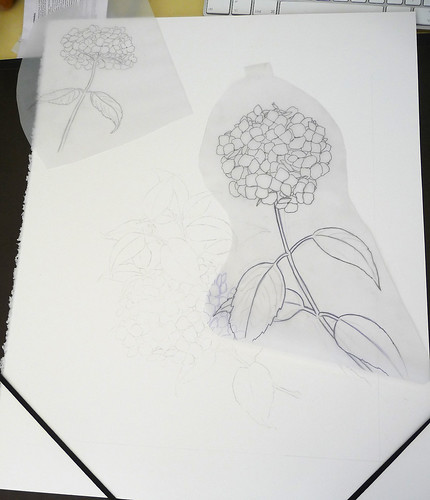
I tried out a little flower first to choose the right colours. That was ok. Now I'm working on my first big flowerhead on the bottom left. It is more blue than the little practice flower I did before. And after a few flowers the colours looked too dirty for me.
Now I'm trying a different approach: colours first, shadows later. I hope it will work.
Sorry for the bad pictures, I can't scan this and have to use my little camera and Photoshop. I will scan the end result though :)
If it will finish and not end up in the dustbin.
The artists from the society got a long list of plants in the Hortus. We all could pick one or two plants to draw. I picked the Hydrangea. It's a shrub I think I would never draw for fun. Too much flowers I guess. But this is a nice oppertunity to try something different. So I thought...
This Hydrangea is so difficult and it's a huge struggle. The sketching was easy and fast. I drew 3 twigs with flowers. The next stage was to make a good composition on the paper. The size of the image is the same for all artists (about 32 x 40 cm).

Now I'm trying a different approach: colours first, shadows later. I hope it will work.
Sorry for the bad pictures, I can't scan this and have to use my little camera and Photoshop. I will scan the end result though :)
If it will finish and not end up in the dustbin.

Sunday, 28 June 2009
Finished!
It took a while but now the drawing of my Honeybells is more or less finished. This evening I scanned the drawing in 3 parts and I merged them together in Photoshop. The stems need a bit more work but the rest is finished. I'm happy this is done because my next project (also a big one) has started to flower this week.

Labels:
botanical,
coloured pencil,
drawing,
flickr,
flowers,
garden,
nature,
Nectaroscordum,
plants,
project
Saturday, 27 June 2009
Burnet ~ Sanguisorba
I love Sanguisorba... I have a few different varieties in my garden and they are starting to flower now. I can't get enough of them. The first one is Sanguisorba officinalis 'Rock and Roll' the other one here is Sanguisorba 'Chocolat Tip'.
Monday, 22 June 2009
More progress
The last couple of days I've worked hard on my big Nectaroscordum drawing. Three of the flowerheads are now, more or less, finished. It's difficult and hard work. I made some photos again to show you what it looks like now. First the entire sheet:
You can see that the right flower is now finished. I've started to draw the buds on the left too. And they are also nearly done. The third is now work in progress and I hope, at the end of the week to start with the last flower. I'm not sure about the placement of the stems but there is nothing I can do about that now....
You can see that the right flower is now finished. I've started to draw the buds on the left too. And they are also nearly done. The third is now work in progress and I hope, at the end of the week to start with the last flower. I'm not sure about the placement of the stems but there is nothing I can do about that now....
Saturday, 20 June 2009
Cherry
This morning I saw a beautiful painting of some cherries a contact of mine (nas740) made in watercolour. This afternoon I had a bowl of cherries on my drawing table and thought I'd give it a go. Here is just one. But it was fun to do because the great dark deep colours and when the drawing was finished it was tasty too :))
Dark side
Come over to the dark side... of my garden that is. Thought I'd make a dark version of the garden photos too. It actually is rather fun to do :)
Thanks Heidi for your sweet words! I'm feeling much better because of them :*

Pastel Garden
I wasn't feeling that well this week. Actually, I'm not feeling well at all for the last ... months. I had some good periods but overall it has been a bit hard lately. So this week, again, I had a bad week and I was very tired. I wanted to draw, I did draw... but the drawing is not going that well if I'm not feeling okay. When I'm not able to draw I like to play a bit with Photoshop. I decided to make this mosaic. These are all small details from photos I made in my garden.

Sunday, 14 June 2009
Nectaroscurdum siculum
I'm trying to work on a project now. It's a bud of the Nectaroscordum siculum in my garden. The bud is opening and the flowers start to come out and bend down gracefully. It's a beautiful process. I did make a small try (well actually not small, it's 1:1) of a bud first:
I made drawings of five stages. I placed them next to each other on the Fabriano and now I have to colour them. It takes a long time and I am very busy doing a lot of other things as well.
But I alsmost finished the first part. The open flower (yes I'm working backwards). The flower was still in my garden and the buds were all gone. I made a lot of photos from the buds so I can work from that. But as long as I had the real thing I could use that. So that's why I started with the last one in the row.
I made drawings of five stages. I placed them next to each other on the Fabriano and now I have to colour them. It takes a long time and I am very busy doing a lot of other things as well.
But I alsmost finished the first part. The open flower (yes I'm working backwards). The flower was still in my garden and the buds were all gone. I made a lot of photos from the buds so I can work from that. But as long as I had the real thing I could use that. So that's why I started with the last one in the row.
Tuesday, 2 June 2009
Rosa glauca
The last two days I was working on a drawing of one of my favourite roses. Rosa glauca. It's a botanical rose with small pink flowers. The leaves are spectacular: grey green with a bit of dark red in the veins and stems. In the autumn the rose has a lot of dark red hips. It's wonderful. I made a drawing of the hips two years ago. I will probably do another one this year or next year since I've sold the first.
The rose is flowering only for a very short period and I had to work fast for this drawing. This morning yesterday's flower had dropped it's petals. I'm happy with the flower and I think the pink resembles the true colour very well. Also the buds and the stem (or branch) are very good I think. The leaves however are a bit of a problem. I don't like doing leaves and the colour of these leaves is very difficult. I managed to draw two leaves and I hope the pink of the flower and the red of the branch will distract the attention from the leaves a bit.
Oh, and about the rose... it's called Rosa glauca, which means Red-leaved rose. The front of the leaf is grey- green but the backside of the leaf is a bit reddish. The veins are red too. It is a species of rose native to the mountains of central and southern Europe.
The rose is flowering only for a very short period and I had to work fast for this drawing. This morning yesterday's flower had dropped it's petals. I'm happy with the flower and I think the pink resembles the true colour very well. Also the buds and the stem (or branch) are very good I think. The leaves however are a bit of a problem. I don't like doing leaves and the colour of these leaves is very difficult. I managed to draw two leaves and I hope the pink of the flower and the red of the branch will distract the attention from the leaves a bit.
Oh, and about the rose... it's called Rosa glauca, which means Red-leaved rose. The front of the leaf is grey- green but the backside of the leaf is a bit reddish. The veins are red too. It is a species of rose native to the mountains of central and southern Europe.

Sunday, 31 May 2009
Rose 'Heritage'
I have this wonderful rose on my table. I'm drawing another rose at the moment but this one has such a wonderful smell...
Thursday, 28 May 2009
Thorns
This is the last drawing I'll show you of my botanical drawing course with Valerie Oxley, three weeks ago. Valerie told us a few remarkable things about the difference between thorns, prickles and spines. She wanted us to make sketches of them. She brought all sorts of painful subjects. Like roses (of course) thistles and Pyracantha (Firethorn). I made a few sketches but I didn't want to make one page with the different branches and leaves. I wanted to end the course in colour and decided to make a coloured pencil drawing of a Berberis twig. I finished the drawing when I got home. I really like this one. The sharp pointy thorns and the beautiful colours were a lot of fun to draw.
The drawing I will not show you is the drawing I made of a Stachys leaf. We learned a few things about painting and drawing hairy and silver coloured leaves. The drawing wasn't very good. Maybe with a bit more experimenting with the different techniques I will come up with a good result but this leaf was a bad experience. The thing I learned that day was that I don't like to draw hairy and silver coloured leaves.
Anyway.... This course was a lot of fun. I met some very nice people again and Valerie Oxley taught me some very good things. I hope you enjoyed this too :)
The drawing I will not show you is the drawing I made of a Stachys leaf. We learned a few things about painting and drawing hairy and silver coloured leaves. The drawing wasn't very good. Maybe with a bit more experimenting with the different techniques I will come up with a good result but this leaf was a bad experience. The thing I learned that day was that I don't like to draw hairy and silver coloured leaves.
Anyway.... This course was a lot of fun. I met some very nice people again and Valerie Oxley taught me some very good things. I hope you enjoyed this too :)

Monday, 18 May 2009
A leaf
I promissed to show you some more results from my botanical drawing course. On Tuesday we did a practice with leaves. How to draw and paint twisted, folded and turned leaves. Most of the ladies in the course made a drawing/painting of a hosta or Persicaria leaf. I was the only one drawing this leaf. The woman who brought this leaf to the course told me it was a Helianthus leaf. But I have big doubts about that. But it doesn't matter very much. It's only a practice after all.
Greens are difficult and leaves can be so very, very hard to draw well. Actually I admire artists that paint a lot of foliage. To paint one or two beautiful leaves is great of course. But to paint a whole bunch of them and do them perfectly.... sigh..... I just don't have the patience to do that.
Anyway... Here's the drawing. Coloured pencil again. And I must say that I'm pretty pleased with it. The fade-away distant colours just happened. I didn't think too much about that.
I had some trouble with the pencils though. The tutor, Valerie Oxley, brought some pencils to the course. I could use them if I wanted to. A nice way to try out some other brands. I tried some greens from the Derwent Coloursoft series. I wish I hadn't. I picked a beautiful Dark Green colour. A super colour for the shadow parts in this leaf. But when I burnished some of it with my white pencil the green turned into a viridian/ cobalt blue greenish colour. Very bright. I tried to get it all out of the leaf, but as you can see... here and there I couldn't. Never mind. It was a good practice and now I'm very sure I don't like the Derwent coloursoft pencils.
Greens are difficult and leaves can be so very, very hard to draw well. Actually I admire artists that paint a lot of foliage. To paint one or two beautiful leaves is great of course. But to paint a whole bunch of them and do them perfectly.... sigh..... I just don't have the patience to do that.
Anyway... Here's the drawing. Coloured pencil again. And I must say that I'm pretty pleased with it. The fade-away distant colours just happened. I didn't think too much about that.
I had some trouble with the pencils though. The tutor, Valerie Oxley, brought some pencils to the course. I could use them if I wanted to. A nice way to try out some other brands. I tried some greens from the Derwent Coloursoft series. I wish I hadn't. I picked a beautiful Dark Green colour. A super colour for the shadow parts in this leaf. But when I burnished some of it with my white pencil the green turned into a viridian/ cobalt blue greenish colour. Very bright. I tried to get it all out of the leaf, but as you can see... here and there I couldn't. Never mind. It was a good practice and now I'm very sure I don't like the Derwent coloursoft pencils.

Saturday, 16 May 2009
Yellow
Last week I joined a 5 day botanical drawing course. My tutor that week was the wonderful Valerie Oxley. The Dutch Society of Botanical Artists invited her over for this masterclass. Every day we practiced a different subject of botanical painting and drawing.
We started on Monday with yellow flowers. Yellow flowers artists often avoid because they are a bit tricky. Not me... I avoided yellow flowers just because I don't like them. But that day there was no excuse, we had to do a yellow flower. A tulip.
The first drawing we did was done by putting in the shadows first and then the colours. (I forgot to tell you that there were people working with watercolour and also some people worked with coloured pencils. I was very happy I wasn't the only one using the pencils) The second drawing was the other way around. You can see here the first drawing on the left and the second drawing on the right.
In the first drawing I used greys for the shadow parts. In the second drawing I used a bit of light violet and warm grey in the darker parts. As always with light coloured flowers (or any other subject with a light colour) I concluded that it's better to work in the shadows later because you have more controle over the colours.
I had fun doing this practice although I still don't like yellow flowers. And I also still believe that yellow tulips is the closest you can get to a plastic-flower-look. Later this week I'll post some more drawings and sketches I made during this course.
We started on Monday with yellow flowers. Yellow flowers artists often avoid because they are a bit tricky. Not me... I avoided yellow flowers just because I don't like them. But that day there was no excuse, we had to do a yellow flower. A tulip.
The first drawing we did was done by putting in the shadows first and then the colours. (I forgot to tell you that there were people working with watercolour and also some people worked with coloured pencils. I was very happy I wasn't the only one using the pencils) The second drawing was the other way around. You can see here the first drawing on the left and the second drawing on the right.
In the first drawing I used greys for the shadow parts. In the second drawing I used a bit of light violet and warm grey in the darker parts. As always with light coloured flowers (or any other subject with a light colour) I concluded that it's better to work in the shadows later because you have more controle over the colours.
I had fun doing this practice although I still don't like yellow flowers. And I also still believe that yellow tulips is the closest you can get to a plastic-flower-look. Later this week I'll post some more drawings and sketches I made during this course.
Saturday, 11 April 2009
Blackthorn
Ever since I saw the drawing by Cicely Mary Barker of the Blackthorn Fairy I love this tree. From the livingroom window I can see one blossoming now. It has something wild, natural, pure and romantic about it. I am not crazy about white flowers or white blossoms but I absolutely love this one.... and still love that wild Flower Fairy too btw :)

Wednesday, 1 April 2009
Romantic
I'm feeling a bit romantic every time I see my Prunus blossom in my garden. I so very much love this little tree.... I made a drawing of it once and a watercolour too (blogged that here). Maybe it's because I just can't get enough of it.
Oh... btw... this is Prunus subhirtella 'Autumnalis' again :)
Tuesday, 24 March 2009
Magnolia
Last weekend I was in Breukelen to visit my parents. I always visit my parents at the end of March because my father is having his birthday. So every year I see the beautiful Magnolia tree in my mother's garden and I love it. I always loved it. It is a small one because they have a small garden but the shape is so nice and I love to sit under it. When you look up at this time of the year you'll see this:
It reminds me of a painting I loved as a child:

It's the "Bloeiende Amandelboom" (Almond Blossom, 1890) by Vincent van Gogh. I haven't seen the real thing for some years now. I'm not sure it still is one of my favorites.
Maybe I liked it because it reminded me of my mother's Magnolia :)
It reminds me of a painting I loved as a child:

It's the "Bloeiende Amandelboom" (Almond Blossom, 1890) by Vincent van Gogh. I haven't seen the real thing for some years now. I'm not sure it still is one of my favorites.
Maybe I liked it because it reminded me of my mother's Magnolia :)

Monday, 9 March 2009
in my garden
This week finally it started to look and feel a bit like spring. The wind is still cold but it was sunny. Today is was raining and snowing again though.... Anyway, the photos I made were taken last week and not today. At last I have some real signs of spring. My first Crocuses are blooming, the snowdrops of course, a lot of plants are making their first leaves and.... my first flowers on the Pulmonarias are here (although it looks like they are shivering in the cold wind).

Akebia quinata bud

Akebia quinata bud
Of course I need to clean up the garden. All the dead plants and leaves from last year are still covering the ground. But before I remove it I'll admire the beauty of last years garden.
The seeds of Anemone 'Hadspen Abudance' are now turning into cotton balls.
The seed heads of the Wild Teasel from last year are still standing in the afternoon sun....
Subscribe to:
Comments (Atom)

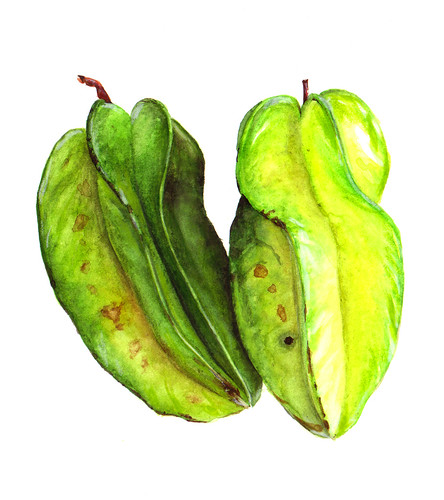
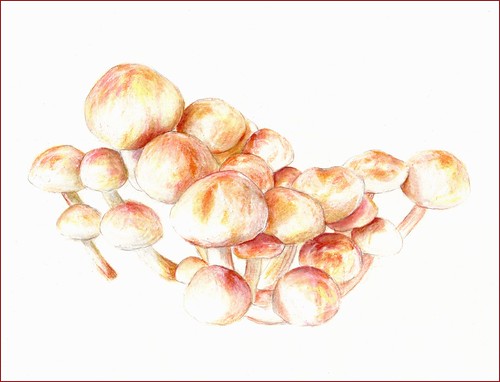
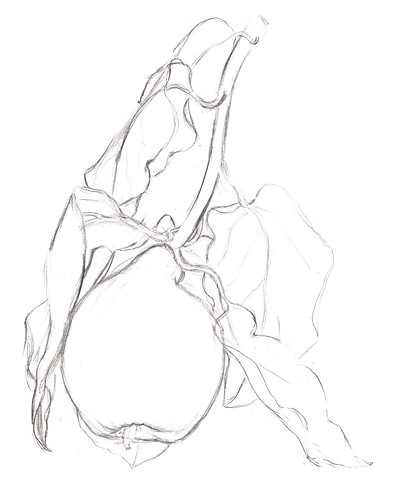
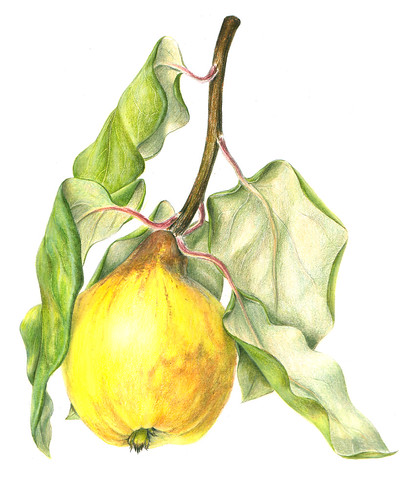
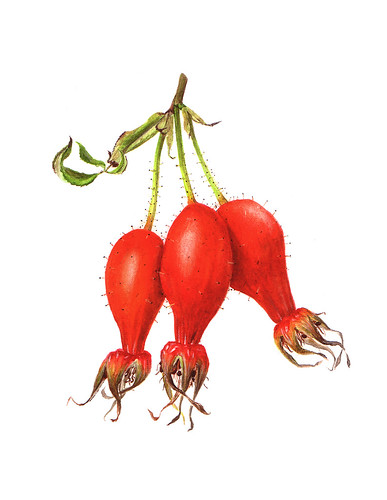
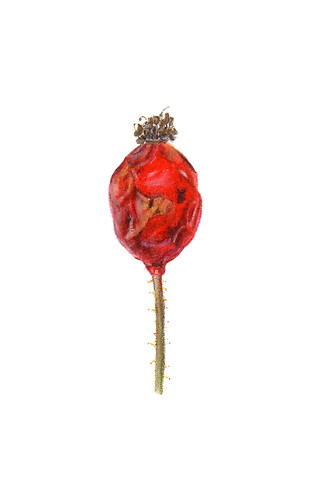
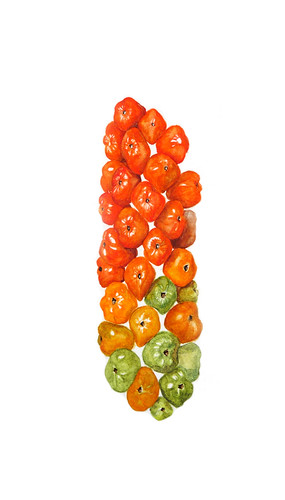

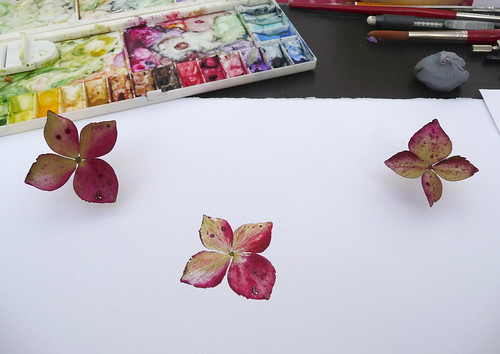
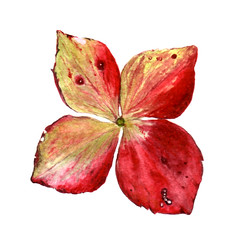
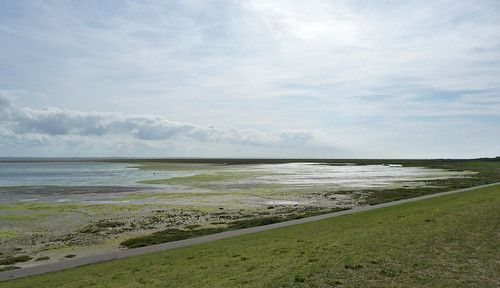


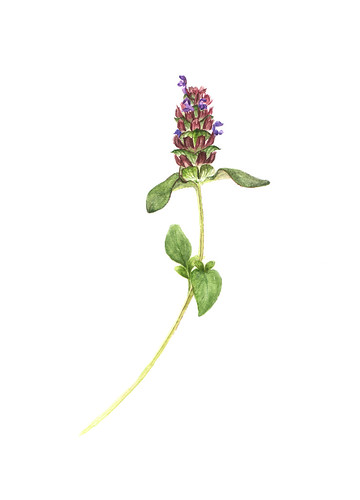
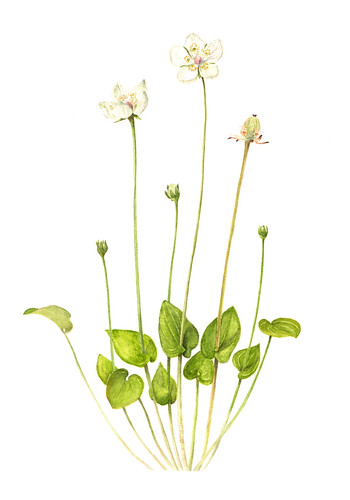
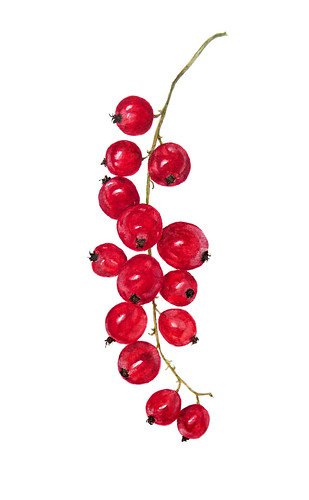






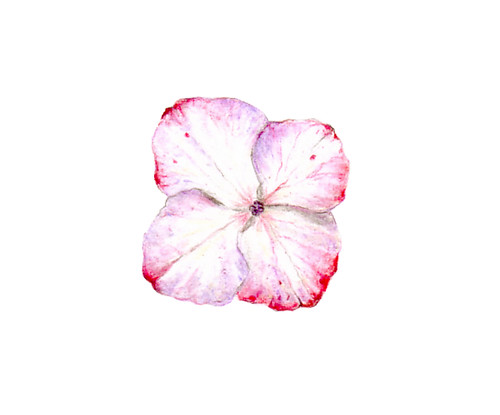
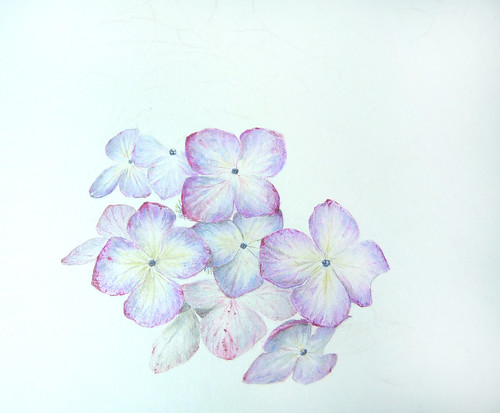
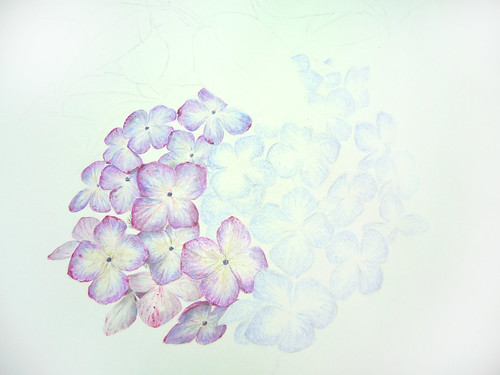


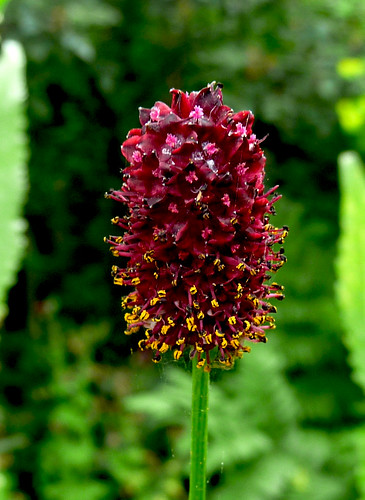
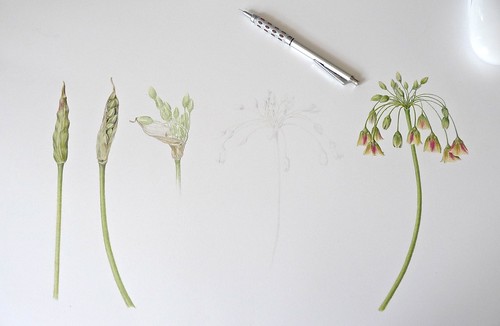
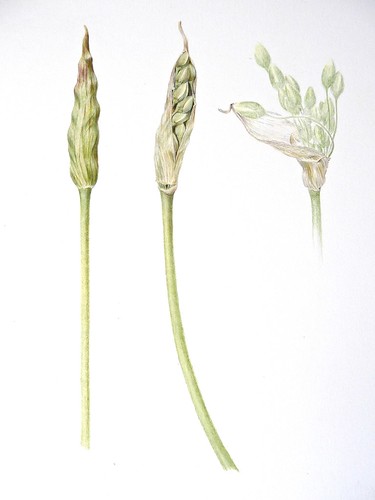
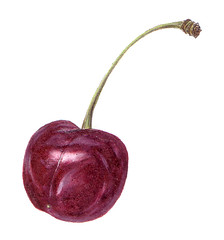
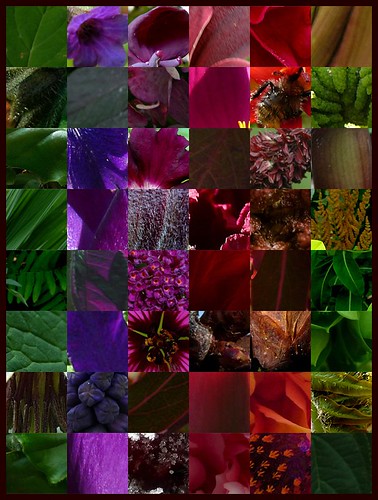
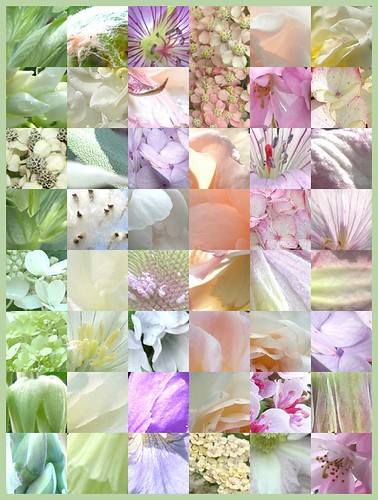
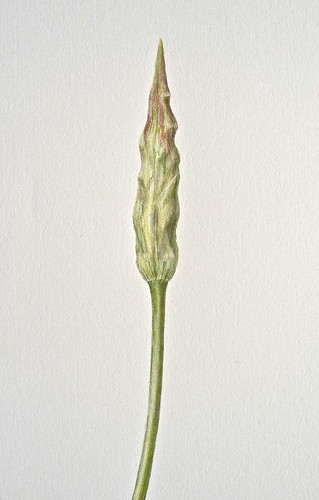
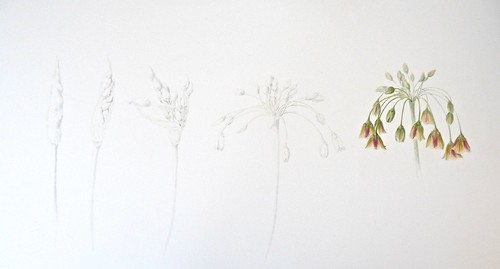
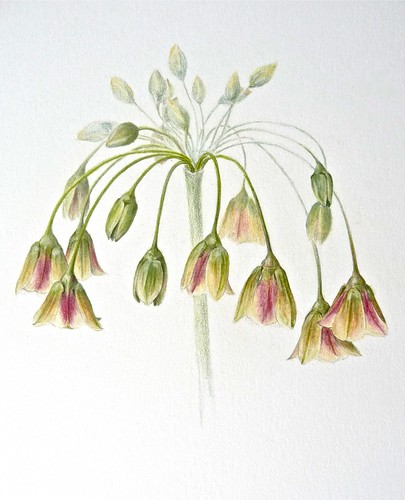
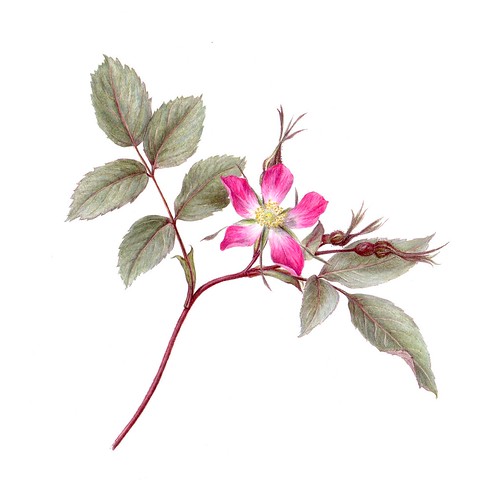
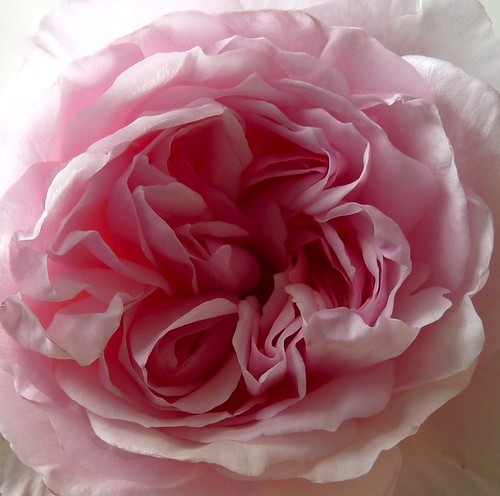
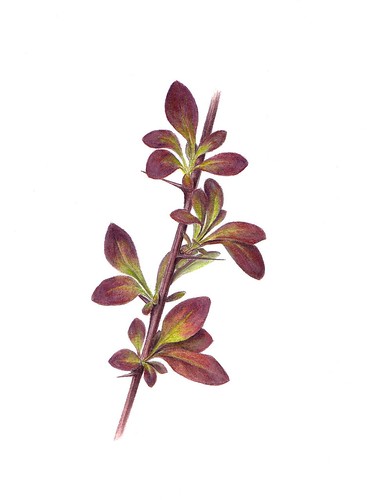

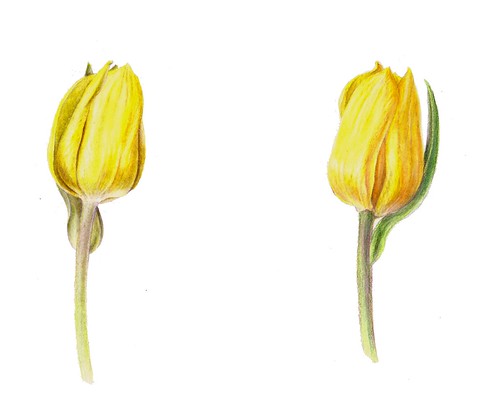
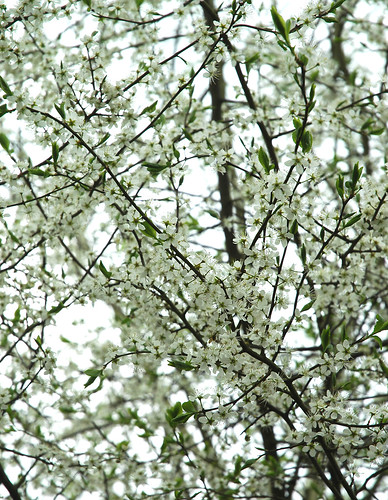

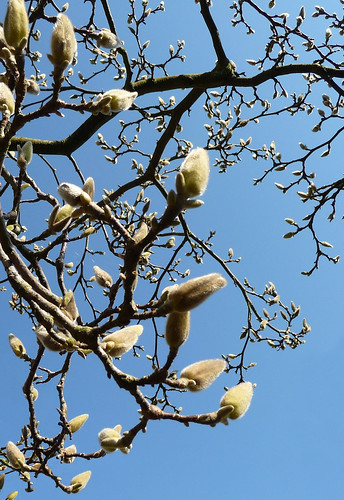
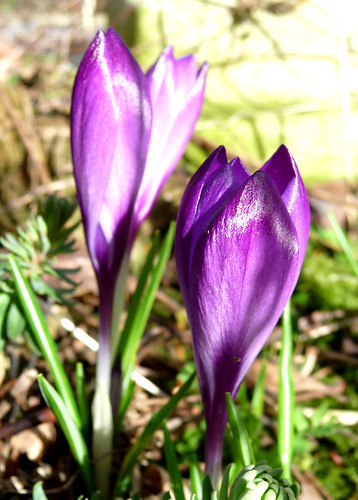

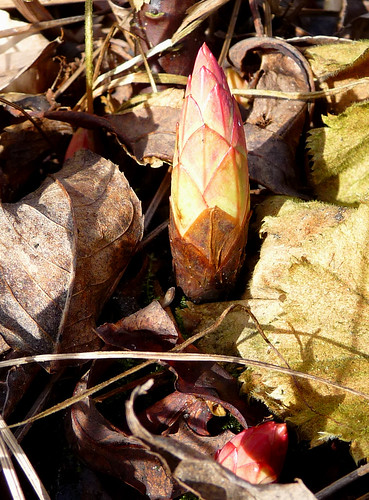
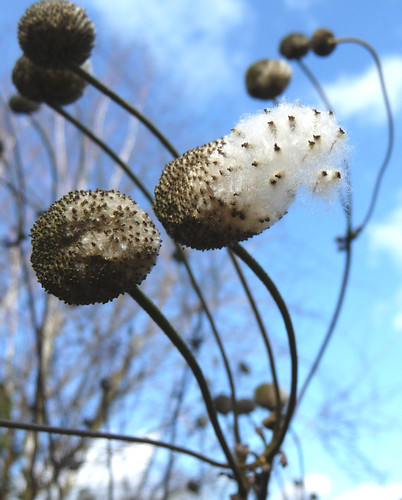












_black_low-res.png)









